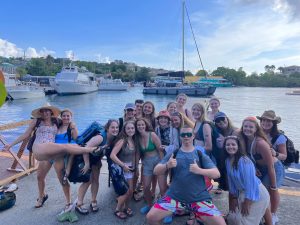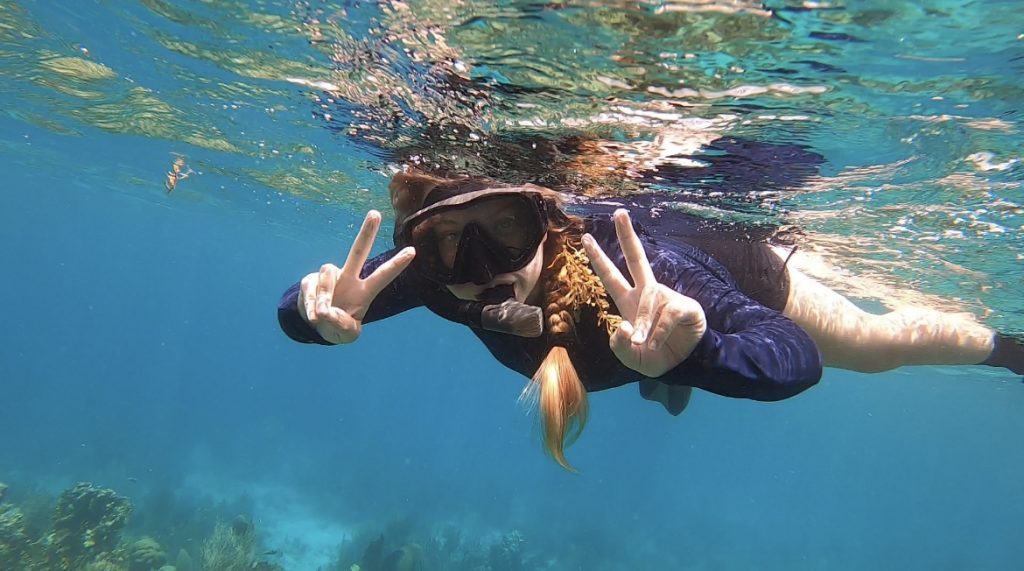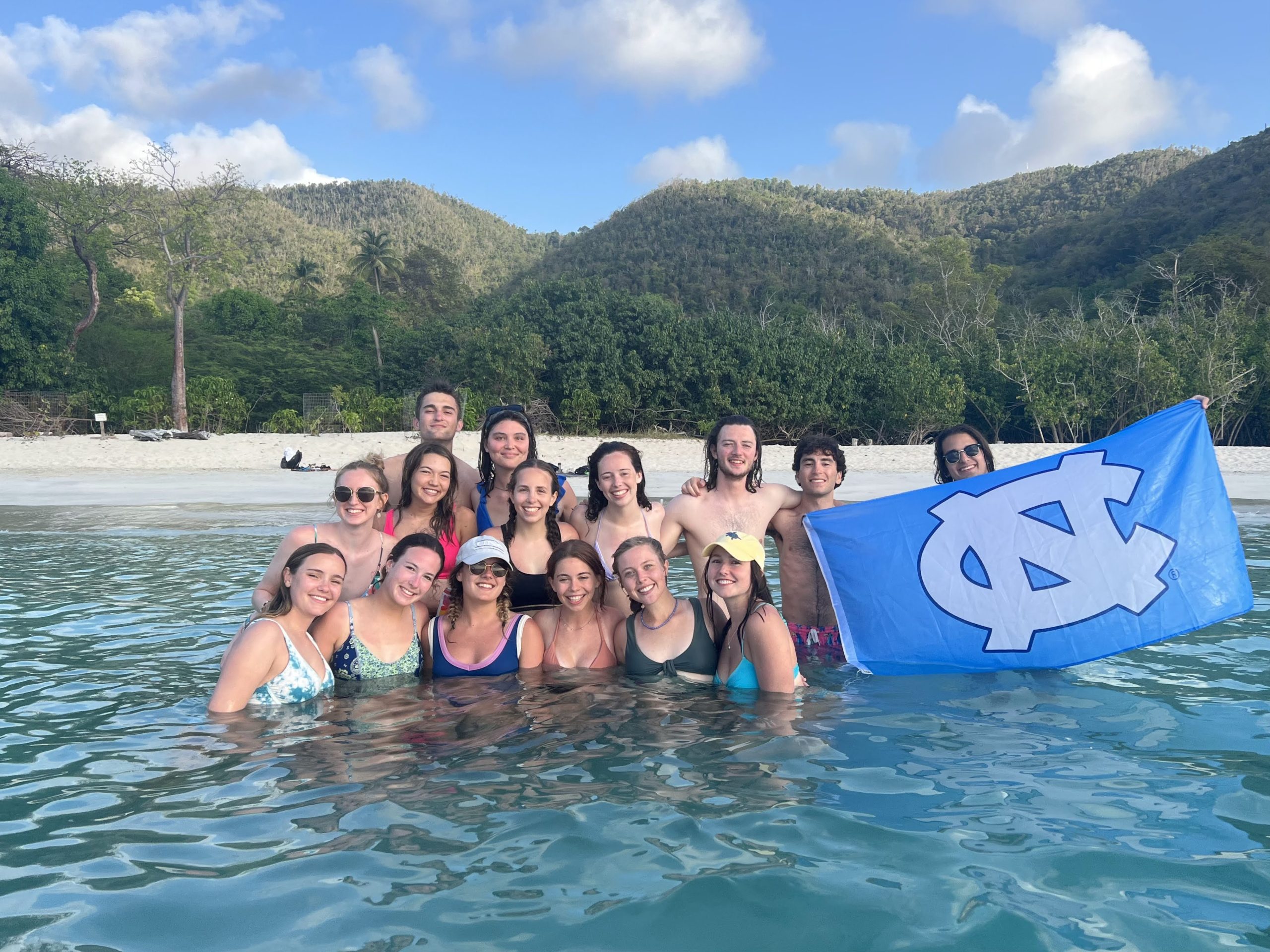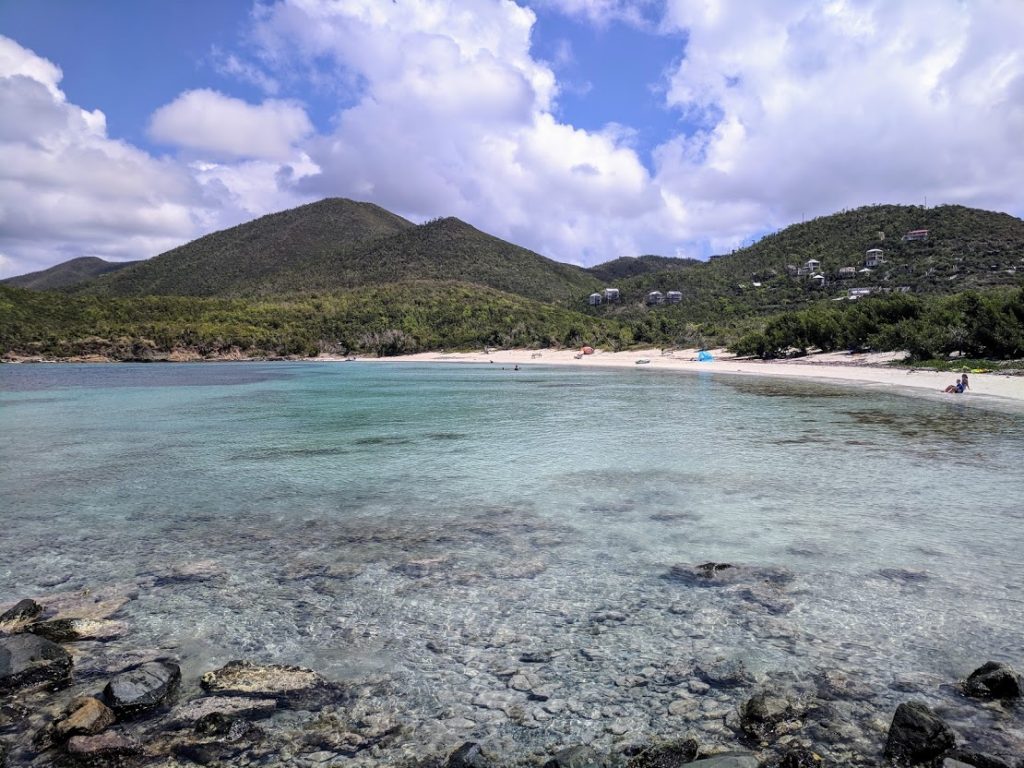Coral Reef Ecology + Management
Coral Reef Ecology and Management (ENEC 259) is a three-hour class that is a combination of lecture, reading of primary material and experiential learning. The course will explore key physical and chemical characteristics of the coral reef environment, topics in coral reef ecology, and strategies available for protecting and managing the reef environment. The course will also familiarize students with the identification of the principal fishes, creatures, and corals found in the Caribbean.
Starting in the Spring of 2013, the students began to research and write a comprehensive Wiki about coral reefs called Coral Digest: www.coraldigest.org. It is a work in progress, but is now used as the class textbook. It is also our hope that the general public will find it to be a useful resource.
The Institute for the Environment (IE) and the Environment, Ecology and Energy Program (E3P) place a strong emphasis on field-based learning. IE runs a number of semester-long field site programs, so this is intended at one level to be an introduction to field based learning, and we hope students will consider engaging in further such experiences in the future.
Finally, we find it important to nurture a strong sense of community amongst our students, so we hope this experience will help build strong bonds of camaraderie and contribute to the intellectual environment within IE.
Goals and Learning Outcomes
- Understanding the basic ecological processes and roles of coral reefs, mangroves, and sea grass beds
- Identifying important Caribbean reef organisms
- Exploring the relationship between reef organisms and benthic habitat
- Educating students about the various threats to coral reefs around the world and exploring management options that can offer some protection to coral reef communities.
This course is offered through Study Abroad in May as “UNC Coral Reef Ecology in the Caribbean.”
May 15 – May 31, 2024 (on St. John May 18 – 27)
St. John, U.S. Virgin Islands
Apply Now
Trip Description
Our class will be traveling to the island of St. John, U.S. Virgin Islands. We will be staying at the recently reopened Cinnamon Bay Campground . We will spend most days snorkeling the amazing fringing reefs that surround St. John, traveling via open air safari taxis. On our last full day on the island, we will circuit the island on a sailboat, stopping to snorkel at some more remote locations.
Important Details
Pre-trip
- Familiarize yourself with the list of things to bring
- Notify your credit card(s) of your trip plans, so that they know to expect charges from the Virgin Islands. We had at least one student’s card get canceled in the past, because the credit card company thought the charges must be fraudulent.
On the island
We’ll explore all of the great snorkeling spots on the island that are accessible by road. We’ll also check out some of the island’s natural and archaeological beauty, including visiting the petroglyphs, and visiting some of the islands historic sugar mill plantation ruins. We’ll generally snorkel during the day and return to the campground around 4 p.m. We will meet as a group to talk about what we saw snorkeling each afternoon. Students enjoy leisure time after dinner.
Flight
Students will need to purchase their own tickets, but students should plan on either traveling on the same flights as listed below or arriving shortly before the flights listed below, so that the entire group can travel. If this is not possible, please notify the instructors, so that separate travel arrangements can be made to ensure that you arrive safely on St. John. Note that students do not need to return to RDU as the course transitions to online/remote starting May 28, 2024.
-
May 18, 2024: American Airlines 1906. RDU to CLT. Departs 8:57 AM, Arrives 10:04 AM.
-
May 18, 2024: American Airlines 2432. CLT to STT. Departs 11:20 AM, Arrives 2:55 PM.
-
May 27, 2024: American Airlines 2432. STT to CLT. Departs 3:35 PM, Arrives 7:40 PM.
-
May 27, 2024: American Airlines 1645. CLT to RDU. Departs 8:59 PM, Arrives 9:55 PM.
General Notes
- It is recommended to have a valid passport with an expiration date greater than six months from the end of the trip or a certified copy of your birth certificate.
- Bring frequent flyer information, if applicable
- You pass through U.S. Customs on your return. PEOPLE UNDER 21 ARE NOT ALLOWED TO BRING LIQUOR BACK INTO THE COUNTRY! If you try it, they will force you to pour your bottles down the drain. For persons over 21, customs allows one bottle of liquor to be brought into the country, free of duty. Our experience tells us it’s best to avoid bringing anything back that may cause extra scrutiny, and you can find everything at the ABC store for a similar price anyway.
Transportation
We will use open-air safari taxis to travel on St. Thomas and St. John. We will take a ferry ride between St. Thomas to St. John.
 Camping
Camping
At Cinnamon Bay, we will be staying in the Eco-tents which can accommodate up to four people. You will be expected to share a tent with at least one other person. Amenities will include: beds (twin bunk beds), sheets, towels, pillow, pillow case, pots/pans/dishware, cook stove, lantern, and picnic table. More details.
- NO place on the island takes state-side checks!! Most places take credit cards, but cash is sometimes your safest bet
- On St. John, the main town Cruz Bay has a couple of grocery stores, numerous places to buy souvenirs, restaurants, and a Dive Shop. If you want to book a dive trip for your free day, we recommend Low Key Watersports. On the other side of the island, a smaller, quieter town called Coral Bay has a few restaurants and shops. We’ll have dinner with Esther at Ekaete Pink Corner.
- Use the buddy system – Someone should always know where you are
- You can get sunburned easily while snorkeling! Reapply sunblock frequently or wear protective clothing when in the water. In addition, sunscreens with the Toxic Three O’s (Oxybenzone, Octinoxate, Octocrylene) are banned in the Virgin Islands. You will need to purchase sunscreen with zinc or titanium oxides as the main ingredients. Here’s a great reef-safe sunscreen guide: https://newsofstjohn.com/reef-safe-sunscreen-guide/.
 Boat Trip
Boat Trip
We will charter a half-day sail around the island, stopping at some amazing snorkeling sites and enjoying one of the most amazing catamarans in the world! Kekoa, a 50′ wooden catamaran handcrafted by brothers Jamison and Ryan Witbeck, survived being abandoned at sea during a winter storm and two of the most powerful hurricanes ever in the Atlantic.
Cost Breakdown
This is a breakdown of estimated costs that are associated with our class trip to St. John, U.S. Virgin Islands. Estimates can vary based on the number of people who enroll. The Study Abroad Program Budget represents the estimated costs that students will be charged.
Fixed
- $300 Study Abroad fee
- $750 (estimate) for camping
- $800 (estimate) for airfare (You will book your own flights, but should match to instructor’s schedule)
- $300 (estimate) for day trip taxis
- $200 (estimate) for chartered boating excursion
- $30 for travel ID book
- $50 Study Abroad application fee
- $21 Global travel insurance
- $50 Application fee
Fixed Total: $2500
Equipment/Other Charges
- $200 for snorkeling equipment (you can share books and borrow equipment, but make sure your snorkeling equipment fits you well, or you’ll get blisters on your feet from ill-fitting fins and water in your mask from ill-fitting masks).
- $100 for a skinsuit or wet suit jacket. Skinsuits are light, full-body suits that will help you avoid getting burned by the sun and getting stung by fire coral and other poisonous underwater hazards, while wet suits will provide warmth if you get cold in the water easily. This is an optional purchase.
- $300 spending money for souvenirs, ferry tickets, etc. This would also include taxi rides to/from town during personal time.
- $300 for food. You can save a lot of money by not eating out every night. Most students bring lots of food with them.
Variable Total: $900
Summary: You can expect to spend about $3,400 on this trip and for the class (and a once-in-a-lifetime experience!).
What to Bring
Packing List
All tents come with sheets, towels, pillow, and a blanket for each person. Tents also include a cooler, a giant plastic storage box, outlets, ceiling fan, shelving, and a lock.
Student Packing ListOther Things to Bring
- Cash – You’ll need around $300 in cash. There are ATMs in Cruz Bay.
- Passport – You’ll need your passport or a certified copy of your birth certificate to travel home from the U.S. Virgin Islands.
- Snorkeling gear – mask, fins, and snorkel. Be aware that booty-less fins can do a number on your feet! It is crucial that your mask fits properly.
- Skin suit, rash guard, or wetsuit top – doubles as protection against the sun and offers some protection against scraping coral or urchins. Wetsuits and wetsuit tops also offer some thermal benefits for long swims. If you get cold in the water, you should consider either a wetsuit top or shorty wetsuit.
- Diving gloves – we do NOT want the students touching everything they see on the reefs. However, it does help to have gloves at times to stabilize yourself, especially if you plan on taking underwater photos.
- Power strip – Each tent only comes with one outlet. If you want to bring rechargeable items like cameras, phones, etc., remember that you will have access to a single outlet for 3 people. There may be outlets in the bathroom(s), and there may be a couple of outlets in the restaurant areas. Recharging, therefore, is limited, and you may find yourself spending a lot of time at the restaurant/bathroom waiting for your devices to charge.
- Sunscreen – Avoid any sunscreen with the Three Toxic O’s (oxybenzone, octinoxate, octocrylene) or avobenzone in the ingredients. These will bleach coral, and are also not good for your skin. Look for reef-safe varieties, which usually contain zinc or titanium oxide. Check out this sunscreen guide: https://newsofstjohn.com/reef-safe-sunscreen-guide/.
- Beach towel, two water bottles (we spend many hours on the beach with little shade), sunglasses, book(s), hat, and drybag (a small drybag that can hold your camera, wallet, etc. proves useful, especially for the boat trip), frisbee, etc. A NPS rule forbids travel hammocks in the national park.
- Flashlight (above and underwater) or headlamp.
- Summer clothing, light pants (optional), shoes or Chacos/Tevas (something with a back strap) to hike in, bathing suit(s), light sweater or long sleeve shirt in case it gets cool at night, rain jacket.
- Food – Bring plenty of snacks to munch on during the day. Most days, we’ll be out in the field. Bring camping food to cook for dinner. We will stop at the grocery store on the way to the campground on the first day, and there will be opportunities to purchase food in town. Check out this Campground Cookbook that students from 2023 put together!
- Bug spray – We strongly recommend that you bring and apply bug spray. You can also bring one of those bug swatters that looks like a tennis racket, which is especially effective at getting rid of the bugs inside your tent before you go to sleep. Light pants and a long-sleeve shirt also prove effective.
- Remember to print out and bring at least one copy of the Species List. We recommend two copies – one to bring to the beach and get wet, one to leave in your tent that you can turn in.
- Class Equipment/Books.
In the days before we leave, we will assign students flashlights, batteries, and ID books. This is because there is too much gear for the leaders to carry down alone. The items then become YOUR RESPONSIBILITY! You are in charge of ensuring that any class books or lights return in good working condition.
Remember to bring ID books (in a waterproof bag) to the beach with us every day. Once we return, you may return the items back to Brian Naess’ office in Europa 4042. Please remember to remove the batteries from the lights before returning the lights.
Meet the Program Leader
 Brian Naess
Brian Naess
GIS Analyst and Lecturer
UNC Institute for the Environment
naess@unc.edu
Brian Naess conducts GIS research on air quality issues and is currently studying transportation-related emissions. He also co-directs the EcoStudio, a UNC-Chapel Hill program that helps undergraduate students obtain sustainability-related internships. Even with his research and responsibilities with the EcoStudio, Naess always looks forward to this St. John adventure and has been a program leader for the last 20 years.
What is the Trip Like?
For all ENEC259 Videos visit: https://www.youtube.com/user/ENST259
More Resources
Links + Educational Resources
Links
Class Wiki
Information about St. John
Information specifically on the GRC and San Salvador
Information about monitoring and management of coral reefs
United States Coral Reef Task Force
http://www.coralreef.gov/
The U.S. Coral Reef Task Force (CRTF) was established to lead the U.S. response to this growing, global environmental crisis.
Global Coral Reef Monitoring Network
http://www.gcrmn.org/
The GCRMN is a network of people, governments, institutes and NGOs monitoring coral reefs in 80 countries and also a partnership of other monitoring programs.
International Coral Reef Information Network
http://www.icriforum.org/
Welcome to the International Directory of Coral Reef Organizations, a database of hundreds of organizations from around the world that work on coral reef related issues, including non-governmental organizations (NGOs), research institutions, aquariums, marine protected areas (MPAs), government agencies, international programs and more.
Educational Resources
Reef Ecology
Hannah Aichelman and Madelyn Roycroft: The Story of Gerald the Lobster: an illustrated children’s story about the role of nursery areas in the life cycle of lobsters (Presented: 2012)
Reef Restoration
Coral Reef Restoration. Author: Lily Clark, Gillings School of Global Public Health, Dept of Environmental Sciences and Engineering. (Posted: May 2009)



